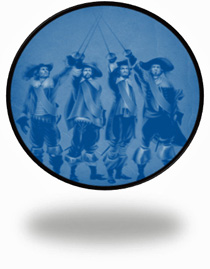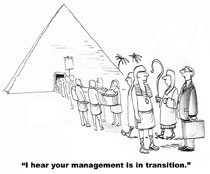 In the January/February issue of HR Magazine, Josh Bersin with Deloitte, makes nine predictions of “what’s in store for HR in 2015.” This is part one of a series of articles looking at each of these predictions.
In the January/February issue of HR Magazine, Josh Bersin with Deloitte, makes nine predictions of “what’s in store for HR in 2015.” This is part one of a series of articles looking at each of these predictions.
The second prediction in this series is that performance management will be redefined - again, thus the title "Play it Again Sam." Over the decades, performance management has endured or enjoyed, depending on your point of view, changes that have affected the workforce in no small measure.
In 1911 Frederick Taylor came up with the concept of scientific management. This concept came out of his observations of inefficiencies in the steel industry. While this method did improve productivity, the work became monotonous and boring. Where have we heard THAT sung before? Charges arose that work had become dehumanizing and this led to investigations by Congress - no small measure indeed.
 What does it mean to be flexible? Maybe for some of us it means we can arrange our schedules to accommodate work and life events. For some it may mean flexibility of opinion. In other words, some people might be willing to change their minds about certain beliefs, thoughts or even convictions. However, flexibility, while on the surface may appear to be fairly straightforward, is made up of three key elements, creativity, integrative ability and self-direction. Let’s look at each of these and see how they combine to ensure flexibility.
What does it mean to be flexible? Maybe for some of us it means we can arrange our schedules to accommodate work and life events. For some it may mean flexibility of opinion. In other words, some people might be willing to change their minds about certain beliefs, thoughts or even convictions. However, flexibility, while on the surface may appear to be fairly straightforward, is made up of three key elements, creativity, integrative ability and self-direction. Let’s look at each of these and see how they combine to ensure flexibility.
Creativity
Creativity is not just the domain of artists, poets or musicians. Everyone can and needs to be creative. Here’s how being creative helps us in our everyday lives. Being creative affords us the ability to better understand and synthesize new information. Furthermore, it opens our minds to a broader range of ideas to help solve problems. The ability to solve problems is essential to any business.
 Teams usually have a mutual goal. Sports teams have a goal to win a game or tournament. Scientific teams might have a goal to find a cure, or gather information or find the source of a problem. Work teams have projects such as improving marketing, conducting customer research or product development to name a few examples. What happens to the team goal if the entire team is not clear on the goal or if each member has his or her own agenda either for the team or themselves?
Teams usually have a mutual goal. Sports teams have a goal to win a game or tournament. Scientific teams might have a goal to find a cure, or gather information or find the source of a problem. Work teams have projects such as improving marketing, conducting customer research or product development to name a few examples. What happens to the team goal if the entire team is not clear on the goal or if each member has his or her own agenda either for the team or themselves?
A few descriptive words that come to mind are chaos, confusion, conflict, and failure. Have any of these ever happened to a team of which you’ve been a member? Have you ever been an observer of a team, such as a sports team, and observed the team falling apart right before your eyes. This can often happen during major playoff games where the pressure to win is even greater than normal. How does this same scenario occur in business teams?
 Do your team’s behaviors emulate the famous musketeer slogan? Can you really have such a utopian culture; or is this idea just as fictional as the musketeer story? If your company is in trouble, is the idea of creating such a team going to distract from more urgent needs? If teambuilding is the only focus – yes. We all know that when teams begin experiencing disruptive behaviors, it is the manifestation of a deeper issue.
Do your team’s behaviors emulate the famous musketeer slogan? Can you really have such a utopian culture; or is this idea just as fictional as the musketeer story? If your company is in trouble, is the idea of creating such a team going to distract from more urgent needs? If teambuilding is the only focus – yes. We all know that when teams begin experiencing disruptive behaviors, it is the manifestation of a deeper issue.
Logic tells us that handling important business issues is imperative. However, your team can be part of that process and creating an “All for one. And one for all.” culture is achievable as is illustrated in the example of DaVita, a company that provides kidney dialysis.
 In ancient Rome, chariot races were one of the main forms of entertainment. In fact, they were, at times, more dangerous than the gladiator fights. These races were run by teams of fearless charioteers who were often as famous as our sport team figures of today. So I began to wonder how charioteer teams of old are like our modern day business teams. OK, maybe I had a little too much time on my hands last week. But stay with me here.
In ancient Rome, chariot races were one of the main forms of entertainment. In fact, they were, at times, more dangerous than the gladiator fights. These races were run by teams of fearless charioteers who were often as famous as our sport team figures of today. So I began to wonder how charioteer teams of old are like our modern day business teams. OK, maybe I had a little too much time on my hands last week. But stay with me here.
Beware: Sharp Turns
Turns are one of the things that made the chariot races so dangerous. The end of the race track had conical tuning-posts or metae indicating a sharp turn that had to be navigated by several chariots at once. Failing to navigate this turn correctly could result in losing control of the chariot, being maimed or even death. Members of teams would attempt to head off other chariots going into these turns.
 The short answer is neither. The longer answer is a bit more complex. Nor is any organization likely to find the perfect workforce regardless of whether they use assessments or not.
The short answer is neither. The longer answer is a bit more complex. Nor is any organization likely to find the perfect workforce regardless of whether they use assessments or not.
The debate over the usefulness, accuracy, and even the legality of assessments has raged on for a number of years. For those who like to categorize everything into the black and white, right or wrong, good or bad piles, the true answer may not be that clear cut. According to recent research by Aberdeen Group, there is a shortage of critical talent and replacing an employee can carry a price tag of upwards of five times a bad hire’s salary. Therefore, it is evident that making good hiring decisions is crucial for an organization’s bottom line. Moreover, the use of assessments can have a positive impact on not only hiring, but retention, performance, and engagement.
Aside from measuring a potential candidate’s interests, backgrounds, strengths, and weaknesses, assessments provide other bonuses.
- Best-in-class organizations are 45% more likely to use pre-hire assessments
- Best-in-class companies are 95% more likely to have a consistent competency model used for hiring, [including using assessments consistently as part of the model].
- Companies that use assessments are 36% more likely to be satisfied with their new hires
- Organizations using pre-hire assessments with performance results are 24% more likely to have employees who exceed performance expectations.
- Businesses using pre-hire assessments in conjugation with performance results have employees who are 17% more likely to rate themselves as engaged.
- Assessments can provide information as to whether or are not an employee is a good cultural fit. Best-in-class companies pass this information along to manager
You can read the full report, Pre-Hire Assessments: An Asset for HR in the Age of the Candidate, at www.aberdeen.com
Those of us who tout the use of assessments as a critical tool in combating turnover, for increasing productivity, and improving customer satisfaction are also aware that cautionary measures must be taken in the use of assessments. So, no they are not the Holy Grail nor are they a wholly failure. Assessments are designed to be used in conjunction with the entire hiring process of implementing good search techniques, establishing performance standards, using good interviewing techniques, reference checking, and drug testing. Here are some other ideas to consider.
T o some, the word power is a four letter word, in other words, a dirty word. Power just means the ability to accomplish work. Power exists and failure to acknowledge it, can prove disastrous. Some people who know they have power may avoid being members of work teams. Others with power may try to unduly exert that power if they are a member of a team. What powers do you have?
o some, the word power is a four letter word, in other words, a dirty word. Power just means the ability to accomplish work. Power exists and failure to acknowledge it, can prove disastrous. Some people who know they have power may avoid being members of work teams. Others with power may try to unduly exert that power if they are a member of a team. What powers do you have?
Power is typically associated with the movers and shakers of the world, like the Donald Trumps, the Warren Buffets or the executives in a corporation. Yes, these types all have power. Does the CEO have more power than a VP just because he or she is the CEO? In most cases, probably yes. However, there are times and circumstances when someone else’s power might trump the CEO’s power. Let’s take a look at the type of powers you might see and use on a daily basis.
Expertise or What You KnowLet’s say you are excellent at negotiation and the CEO is not. You might be called into the trenches to land the next big deal with your negotiation skills. You have the power - at least for the "moment." Having information or expertise can also be used in power plays to embarrass, surprise or frustrate someone.
 Being consistent is akin to having a good brand. Think of it as part of your personal power. Being a consistent performer at a high level, gives us personal power. This applies to performance teams as well. How can an individual or a team walk the talk if they fail to produce at a high level consistently? Therein lies the rub, what does it take to be consistent, consistently?
Being consistent is akin to having a good brand. Think of it as part of your personal power. Being a consistent performer at a high level, gives us personal power. This applies to performance teams as well. How can an individual or a team walk the talk if they fail to produce at a high level consistently? Therein lies the rub, what does it take to be consistent, consistently?
Define Your Brand
Most every organization has a mission statement. Teams, too, should have a mission statement as well. Certainly the mission statement should be in alignment with the organization’s, but be clear in representing what your team stands for, the work it produces and the value it brings to the table. Every team member should be on board with the team’s mission statement and live its philosophy each day.
 Being a Hollywood actor is a top dream job. People also dream about being rock stars, writing a book, and starting their own business. Oftentimes, what people fail to see in their dreams are the blood, sweat, and tears that go into making these dreams a reality. For example, people see writing a book as a piece of cake. However, a quote from the author and journalist Gene Fowler (1890-1960) cooks up a different image: “Writing is easy: All you do is sit staring at a blank sheet of paper until drops of blood form on your forehead.” Similar sentiments apply to acting.
Being a Hollywood actor is a top dream job. People also dream about being rock stars, writing a book, and starting their own business. Oftentimes, what people fail to see in their dreams are the blood, sweat, and tears that go into making these dreams a reality. For example, people see writing a book as a piece of cake. However, a quote from the author and journalist Gene Fowler (1890-1960) cooks up a different image: “Writing is easy: All you do is sit staring at a blank sheet of paper until drops of blood form on your forehead.” Similar sentiments apply to acting.
The actor Chuck Norris states: “Whatever luck I had, I made. I was never a natural athlete, but I paid my dues in sweat and concentration and took the time necessary to learn karate and become world champion.” Tears often fall into the mix, especially during times of defeat.
 Studies indicate that those with a positive mental attitude or PMA as it's often referred to, has a well, positive impact on people’s lives in general. According to an article in the Chicago Tribune
Studies indicate that those with a positive mental attitude or PMA as it's often referred to, has a well, positive impact on people’s lives in general. According to an article in the Chicago Tribune
‘Thousands of articles in virtually all popular, medical, health and news journals
tout the benefits of PMA on longevity and many other positive aspects of aging,’
says Dr. Peter Norvid, a geriatric specialist treating patients at Adventist Hinsdale
and La Grange Memorial hospitals and medical director for Heartland Hospice.
‘Optimistic people live longer, have closer personal relationships and are able
to deal with the negative things that happen to them in a way that allows them
to continue to be able to be there for others so that others can help them.’
But can this same PMA have a positive effect in the workplace?
According to an article in HR Magazine by Aileen Wilkins, that would be affirmative – to a point. In other words, while a toxic culture breeds “unhealthy internal politics and dysfunction”, a more positive culture can lead the way for people to “focus on growth, minimize internal politics, and constructively support and challenge each to do better.” Further, employees are more engaged. Ms. Wilkins is not claiming that people will go around singing “The Happy Song” or even be joyous, but simply that people will work together better and be more productive.
 There is a lot of rhetoric out there about finding people with the right combination of knowledge, skills, and attributes or KSAs, and then understanding how particular sets of KSAs need to work together to complete projects. Part of the confusion centers around finding these mixes of talent. Do these people come from the recruiting process, are they people within the organization whom we can train, or are there people on other teams within the organization who might have a skill mismatch and would perform brilliantly on another project?
There is a lot of rhetoric out there about finding people with the right combination of knowledge, skills, and attributes or KSAs, and then understanding how particular sets of KSAs need to work together to complete projects. Part of the confusion centers around finding these mixes of talent. Do these people come from the recruiting process, are they people within the organization whom we can train, or are there people on other teams within the organization who might have a skill mismatch and would perform brilliantly on another project?
Some management research and instructional elements don’t help as with this example of Combo Mumbo Jumbo. “In an effort to establish a career and talent combination mechanism, an empirical analysis was conducted of the performance level of the administration of the senior executive knowledge base, both accredited and non-accredited, skill expertise, both innate and acquired, and the internality of individualistic attributes.” Seriously? Is that even legal in your state?
Having teams with the right combination of talents isn’t rocket science or combo mumbo jumbo. The answer to the question in the first paragraph is yes. The right combination of talent can come from either inside or outside your organization. Let’s review.
 On one hand, culture appears to be too full of fluff for some leaders. Phrases like, “I’m not here to make friends, I have a business to run!” come to mind. On the other hand, phrases like “Our culture drives productivity, great customer service, and that grows profits.” might waft through the corporate rafters. So which is it? Is culture a hard or soft business element? In a word, yes. Culture is a two headed monster that dares you to wrestle with it…and wrestle with it you must.
On one hand, culture appears to be too full of fluff for some leaders. Phrases like, “I’m not here to make friends, I have a business to run!” come to mind. On the other hand, phrases like “Our culture drives productivity, great customer service, and that grows profits.” might waft through the corporate rafters. So which is it? Is culture a hard or soft business element? In a word, yes. Culture is a two headed monster that dares you to wrestle with it…and wrestle with it you must.
Neglecting culture is like failing to feed a caged monster. One day, it will break loose and eat you alive and have your business for dessert. Culture has come to be defined as “The way we do things around here.” There is another saying, “If you do what you’ve always done, you’ll get what you’ve always got.” However, in the face of necessary business change, not making the changes won’t get you what you’ve always got, business will change, but for the worse. In other words, current operational processes, policies, and principles need to change in order to meet current market needs.
 When you have a cold, it is easy to diagnose the problem from the symptoms you suffer. You cough, your head is stuffy and you have no energy. In business, there may be clues that a problem exists. However, diagnoses may not be as evident as what happens when we contract the common cold. The good news is that information abounds on solving problems. There are even problem solving models that act as a guide if one doesn’t know where to begin on solving a problem. So let’s look at some steps that can help solve business problems.
When you have a cold, it is easy to diagnose the problem from the symptoms you suffer. You cough, your head is stuffy and you have no energy. In business, there may be clues that a problem exists. However, diagnoses may not be as evident as what happens when we contract the common cold. The good news is that information abounds on solving problems. There are even problem solving models that act as a guide if one doesn’t know where to begin on solving a problem. So let’s look at some steps that can help solve business problems.
To begin, someone in the organization has to have a clue that a problem exits. Of course, more than likely the symptoms show up first, for example, poor sales, a lack of productivity, staffing problems and maybe even chaos. However, seeing the symptoms doesn’t always guarantee the diagnosis. Diagnosing business problems takes a few steps.
- Recognition that a problem exists is first. Leaders who put their heads in the sand and ignore problems are part of the problem and of course, this causes the problem to fester. Business failure can follow. Therefore, this is an important step.
 Carter McNamara, http://goo.gl/bIK5XA, a well-known business consultant, states,
Carter McNamara, http://goo.gl/bIK5XA, a well-known business consultant, states,
"The system's overall behavior depends on its entire structure (not the sum of its various parts). The structure determines the various behaviors, which determine the various events. Too often, we only see and respond to the events. That's why, especially in the early parts of our lives, we can be so short-sighted and reactionary in our lives and in our work. We miss the broader scheme of things."
This concept is something I strive to instill in coaching clients by helping them to see their lives and their careers as a system. No, it’s not too romantic, but it does help the thinking, analytical, and goal setting process to take roots. This applies to business, management, and leadership as well.
 Think about your favorite movie star. He or she probably has “it.” In the case of movie stars “it” is described as having a certain sexual appeal. OK, we’re not going there with teams. The “it” referred to here is communication. While communication may not sound too appealing in a sexy sort of way, it, or rather communication, does serve as a measurement and conduit in team building. You may think that factors such as communication and team productivity do not present hard and fast facts and they are not measureable. Well, now we have scientific evidence and the measurements to back these up.
Think about your favorite movie star. He or she probably has “it.” In the case of movie stars “it” is described as having a certain sexual appeal. OK, we’re not going there with teams. The “it” referred to here is communication. While communication may not sound too appealing in a sexy sort of way, it, or rather communication, does serve as a measurement and conduit in team building. You may think that factors such as communication and team productivity do not present hard and fast facts and they are not measureable. Well, now we have scientific evidence and the measurements to back these up.
Alex “Sandy” Pentland recently conducted research on teams with varying performance. His research was conducted in a variety of industries and teams from innovative to backroom operations and call centers to name a few. The measurement instrument was in the form of an electronic badge that the teams wore around their necks. The badges collected data on tone of voice, body language, whom they talked to and more. Yes, the data was based on the questions who, what, why and where. One of the interesting findings is that the “what” didn’t matter. In other words, what these individuals (the who) were discussing didn’t matter, just that they were communicating. The “where” is the conversations that were held outside of the regular work meetings or in the less formal environments like on break or at lunch. Here’s what the study revealed.
 Got business acumen? What is business acumen? And what does business acumen have to do with building a better career?
Got business acumen? What is business acumen? And what does business acumen have to do with building a better career?
This article discusses business acumen, what it is, and how it can help you build a better career.
Business acumen is the ability to see and take advantage of opportunities, understand, and communicate with every behavioral type at every level of your organization, solve problems, make good decisions, have discernment, and focus on the right priorities at the right time.
 Wouldn’t it be great to roll through each work day with a team that is collaborative, communicates well, values training and development, and has a genuine concern for the future leadership of the organization? Or is your team rolling on deflated tires? Is a team such as the description gone the way of Ford’s Edsel? (OK, I’m dating myself now, and you younger readers, just Google it). Such a team does exist at Goodyear North America. First a brief scenario of how this team began its journey as conveyed in the August issue of HR Magazine.
Wouldn’t it be great to roll through each work day with a team that is collaborative, communicates well, values training and development, and has a genuine concern for the future leadership of the organization? Or is your team rolling on deflated tires? Is a team such as the description gone the way of Ford’s Edsel? (OK, I’m dating myself now, and you younger readers, just Google it). Such a team does exist at Goodyear North America. First a brief scenario of how this team began its journey as conveyed in the August issue of HR Magazine.
Their journey began with two questions, 1) who would replace current leaders? and 2) how was the company preparing future leaders? In addition, business pressures from global competition and volatile economic conditions were looming. Something had to be done. The decision was made to restructure the company. Now the team was able to identify the type of leadership the company would need to drive it forward. This, in turn, helped the team to identify the type of development these leaders needed to steer the company in the right direction. The team made the commitment to develop the process and put it in place to accelerate the shift. How does a company develop such a team?
Goodyear North America paved the way for their executives by laying out a roadmap taking each executive and the team to their destination of creating a tandem team.
 It’s no secret that training is the first on the chopping block in organizations when times get tough. Many trainers lament the fact that they get no respect. Regrettably, there is often good reason for these opinions.
It’s no secret that training is the first on the chopping block in organizations when times get tough. Many trainers lament the fact that they get no respect. Regrettably, there is often good reason for these opinions.
According to a 2015 study by Training, Organizations spend around $70 Billion on training. Many times this hefty price tag comes with no ROI. CEOs are pulling their hair out over the failure of training programs. This includes both inside and outside training programs. A typical example is communication.
Upon a few communication failures such as information being withheld, unnecessary communication, not enough communication, inappropriate communication, the wrong communication, etc., etc., etc. someone in management calls for communication training, Dutifully, the in-house trainer slaps together a communication training and everyone is required to attend, they also must sign off that they’ve been, and there may even be penalties if one does not attend. Of course, managers are exempt from attending. Everyone attends and six-weeks later, there are more communication fiascos. Sound familiar? What can be done to stop such training wrecks? Keeping with our communication example…
 Change is rarely easy. Transitions in leadership fall into the change arena and not only is it rarely easy, a CEO transition, whether planned or unexpected, can lead to chaos if not handled with care. If there are extenuating circumstances around the transition, life can become an out of control roller coaster with a broken stop button. As with any other change, there are ways to prepare for eventualities and prevent catastrophes.
Change is rarely easy. Transitions in leadership fall into the change arena and not only is it rarely easy, a CEO transition, whether planned or unexpected, can lead to chaos if not handled with care. If there are extenuating circumstances around the transition, life can become an out of control roller coaster with a broken stop button. As with any other change, there are ways to prepare for eventualities and prevent catastrophes.
Succession Planning: Succession planning plays a large role and this responsibility falls squarely on the shoulder’s of the Board and the current CEO – unless, of course, the current CEO is going to be asked to leave prematurely. The problem is that Boards meet, at the most, monthly. Some organizational Boards meet even more infrequently. Therefore, succession planning should be on the agenda at every Board meeting. Some organizations select a hiring committee to aid in the search as well. An outside adviser or consultant can aid in the process as well. Spending a lot of time on the selection of the next CEO does not guarantee success. There are a lot of companies that make the transition successful spending little time in the effort. However, there are certain elements and processes that help every executive transition flow better.
Yes, if you do teambuilding like the typical  rah, rah, let’s come together and sing Khumbaya team building sessions. Or how about a retreat with those spray paint ball gun games? One time, our company went on one of those. It was out in the boonies, it was cold as the dickens and we had to use outdoor toilets. Yeah, that really made me want to be productive and hug management. Growing up, we had an outhouse and I’ve worked hard not to have to “go there” again. And finally, there’s the very popular afternoon at Dave and Buster’s. OK, yes it’s indoors, no one is shooting at you and there is usually indoor plumbing. On the other hand, it’s noisy and no opportunity for any in depth conversations. So forget about building a relationship. Everyone goes in eight different directions to find their own favorite brand of, well we’re here and we’ve gotta’ do something. Usually, there is not even a meal together as everyone eats at different times whenever the mood hits them or they get hungry and just leave. I don’t know about you, but I’m not really feelin” it here. So let’s look at what teambuilding is for and when it’s appropriate.
rah, rah, let’s come together and sing Khumbaya team building sessions. Or how about a retreat with those spray paint ball gun games? One time, our company went on one of those. It was out in the boonies, it was cold as the dickens and we had to use outdoor toilets. Yeah, that really made me want to be productive and hug management. Growing up, we had an outhouse and I’ve worked hard not to have to “go there” again. And finally, there’s the very popular afternoon at Dave and Buster’s. OK, yes it’s indoors, no one is shooting at you and there is usually indoor plumbing. On the other hand, it’s noisy and no opportunity for any in depth conversations. So forget about building a relationship. Everyone goes in eight different directions to find their own favorite brand of, well we’re here and we’ve gotta’ do something. Usually, there is not even a meal together as everyone eats at different times whenever the mood hits them or they get hungry and just leave. I don’t know about you, but I’m not really feelin” it here. So let’s look at what teambuilding is for and when it’s appropriate.
Teambuilding is not meant for creating false “bonding” events, but rather for the following business strategies:
 In the January/February issue of HR Magazine, Josh Bersin with Deloitte, makes nine predictions of “what’s in store for HR in 2015.” This is part one of a series of articles looking at each of these predictions.
In the January/February issue of HR Magazine, Josh Bersin with Deloitte, makes nine predictions of “what’s in store for HR in 2015.” This is part one of a series of articles looking at each of these predictions. What does it mean to be flexible? Maybe for some of us it means we can arrange our schedules to accommodate work and life events. For some it may mean flexibility of opinion. In other words, some people might be willing to change their minds about certain beliefs, thoughts or even convictions. However, flexibility, while on the surface may appear to be fairly straightforward, is made up of three key elements, creativity, integrative ability and self-direction. Let’s look at each of these and see how they combine to ensure flexibility.
What does it mean to be flexible? Maybe for some of us it means we can arrange our schedules to accommodate work and life events. For some it may mean flexibility of opinion. In other words, some people might be willing to change their minds about certain beliefs, thoughts or even convictions. However, flexibility, while on the surface may appear to be fairly straightforward, is made up of three key elements, creativity, integrative ability and self-direction. Let’s look at each of these and see how they combine to ensure flexibility. Teams usually have a mutual goal. Sports teams have a goal to win a game or tournament. Scientific teams might have a goal to find a cure, or gather information or find the source of a problem. Work teams have projects such as improving marketing, conducting customer research or product development to name a few examples. What happens to the team goal if the entire team is not clear on the goal or if each member has his or her own agenda either for the team or themselves?
Teams usually have a mutual goal. Sports teams have a goal to win a game or tournament. Scientific teams might have a goal to find a cure, or gather information or find the source of a problem. Work teams have projects such as improving marketing, conducting customer research or product development to name a few examples. What happens to the team goal if the entire team is not clear on the goal or if each member has his or her own agenda either for the team or themselves? Do your team’s behaviors emulate the famous musketeer slogan? Can you really have such a utopian culture; or is this idea just as fictional as the musketeer story? If your company is in trouble, is the idea of creating such a team going to distract from more urgent needs? If teambuilding is the only focus – yes. We all know that when teams begin experiencing disruptive behaviors, it is the manifestation of a deeper issue.
Do your team’s behaviors emulate the famous musketeer slogan? Can you really have such a utopian culture; or is this idea just as fictional as the musketeer story? If your company is in trouble, is the idea of creating such a team going to distract from more urgent needs? If teambuilding is the only focus – yes. We all know that when teams begin experiencing disruptive behaviors, it is the manifestation of a deeper issue. In ancient Rome, chariot races were one of the main forms of entertainment. In fact, they were, at times, more dangerous than the gladiator fights. These races were run by teams of fearless charioteers who were often as famous as our sport team figures of today. So I began to wonder how charioteer teams of old are like our modern day business teams. OK, maybe I had a little too much time on my hands last week. But stay with me here.
In ancient Rome, chariot races were one of the main forms of entertainment. In fact, they were, at times, more dangerous than the gladiator fights. These races were run by teams of fearless charioteers who were often as famous as our sport team figures of today. So I began to wonder how charioteer teams of old are like our modern day business teams. OK, maybe I had a little too much time on my hands last week. But stay with me here. The short answer is neither. The longer answer is a bit more complex. Nor is any organization likely to find the perfect workforce regardless of whether they use assessments or not.
The short answer is neither. The longer answer is a bit more complex. Nor is any organization likely to find the perfect workforce regardless of whether they use assessments or not. o some, the word power is a four letter word, in other words, a dirty word. Power just means the ability to accomplish work. Power exists and failure to acknowledge it, can prove disastrous. Some people who know they have power may avoid being members of work teams. Others with power may try to unduly exert that power if they are a member of a team. What powers do you have?
o some, the word power is a four letter word, in other words, a dirty word. Power just means the ability to accomplish work. Power exists and failure to acknowledge it, can prove disastrous. Some people who know they have power may avoid being members of work teams. Others with power may try to unduly exert that power if they are a member of a team. What powers do you have? Being consistent is akin to having a good brand. Think of it as part of your personal power. Being a consistent performer at a high level, gives us personal power. This applies to performance teams as well. How can an individual or a team walk the talk if they fail to produce at a high level consistently? Therein lies the rub, what does it take to be consistent, consistently?
Being consistent is akin to having a good brand. Think of it as part of your personal power. Being a consistent performer at a high level, gives us personal power. This applies to performance teams as well. How can an individual or a team walk the talk if they fail to produce at a high level consistently? Therein lies the rub, what does it take to be consistent, consistently? Being a Hollywood actor is a top dream job. People also dream about being rock stars, writing a book, and starting their own business. Oftentimes, what people fail to see in their dreams are the blood, sweat, and tears that go into making these dreams a reality. For example, people see writing a book as a piece of cake. However, a quote from the author and journalist Gene Fowler (1890-1960) cooks up a different image: “Writing is easy: All you do is sit staring at a blank sheet of paper until drops of blood form on your forehead.” Similar sentiments apply to acting.
Being a Hollywood actor is a top dream job. People also dream about being rock stars, writing a book, and starting their own business. Oftentimes, what people fail to see in their dreams are the blood, sweat, and tears that go into making these dreams a reality. For example, people see writing a book as a piece of cake. However, a quote from the author and journalist Gene Fowler (1890-1960) cooks up a different image: “Writing is easy: All you do is sit staring at a blank sheet of paper until drops of blood form on your forehead.” Similar sentiments apply to acting. Studies indicate that those with a positive mental attitude or PMA as it's often referred to, has a well, positive impact on people’s lives in general. According to an article in the Chicago Tribune
Studies indicate that those with a positive mental attitude or PMA as it's often referred to, has a well, positive impact on people’s lives in general. According to an article in the Chicago Tribune There is a lot of rhetoric out there about finding people with the right combination of knowledge, skills, and attributes or KSAs, and then understanding how particular sets of KSAs need to work together to complete projects. Part of the confusion centers around finding these mixes of talent. Do these people come from the recruiting process, are they people within the organization whom we can train, or are there people on other teams within the organization who might have a skill mismatch and would perform brilliantly on another project?
There is a lot of rhetoric out there about finding people with the right combination of knowledge, skills, and attributes or KSAs, and then understanding how particular sets of KSAs need to work together to complete projects. Part of the confusion centers around finding these mixes of talent. Do these people come from the recruiting process, are they people within the organization whom we can train, or are there people on other teams within the organization who might have a skill mismatch and would perform brilliantly on another project? On one hand, culture appears to be too full of fluff for some leaders. Phrases like, “I’m not here to make friends, I have a business to run!” come to mind. On the other hand, phrases like “Our culture drives productivity, great customer service, and that grows profits.” might waft through the corporate rafters. So which is it? Is culture a hard or soft business element? In a word, yes. Culture is a two headed monster that dares you to wrestle with it…and wrestle with it you must.
On one hand, culture appears to be too full of fluff for some leaders. Phrases like, “I’m not here to make friends, I have a business to run!” come to mind. On the other hand, phrases like “Our culture drives productivity, great customer service, and that grows profits.” might waft through the corporate rafters. So which is it? Is culture a hard or soft business element? In a word, yes. Culture is a two headed monster that dares you to wrestle with it…and wrestle with it you must. When you have a cold, it is easy to diagnose the problem from the symptoms you suffer. You cough, your head is stuffy and you have no energy. In business, there may be clues that a problem exists. However, diagnoses may not be as evident as what happens when we contract the common cold. The good news is that information abounds on solving problems. There are even problem solving models that act as a guide if one doesn’t know where to begin on solving a problem. So let’s look at some steps that can help solve business problems.
When you have a cold, it is easy to diagnose the problem from the symptoms you suffer. You cough, your head is stuffy and you have no energy. In business, there may be clues that a problem exists. However, diagnoses may not be as evident as what happens when we contract the common cold. The good news is that information abounds on solving problems. There are even problem solving models that act as a guide if one doesn’t know where to begin on solving a problem. So let’s look at some steps that can help solve business problems. Carter McNamara,
Carter McNamara,  Think about your favorite movie star. He or she probably has “it.” In the case of movie stars “it” is described as having a certain sexual appeal. OK, we’re not going there with teams. The “it” referred to here is communication. While communication may not sound too appealing in a sexy sort of way, it, or rather communication, does serve as a measurement and conduit in team building. You may think that factors such as communication and team productivity do not present hard and fast facts and they are not measureable. Well, now we have scientific evidence and the measurements to back these up.
Think about your favorite movie star. He or she probably has “it.” In the case of movie stars “it” is described as having a certain sexual appeal. OK, we’re not going there with teams. The “it” referred to here is communication. While communication may not sound too appealing in a sexy sort of way, it, or rather communication, does serve as a measurement and conduit in team building. You may think that factors such as communication and team productivity do not present hard and fast facts and they are not measureable. Well, now we have scientific evidence and the measurements to back these up. Got business acumen? What is business acumen? And what does business acumen have to do with building a better career?
Got business acumen? What is business acumen? And what does business acumen have to do with building a better career? Wouldn’t it be great to roll through each work day with a team that is collaborative, communicates well, values training and development, and has a genuine concern for the future leadership of the organization? Or is your team rolling on deflated tires? Is a team such as the description gone the way of Ford’s Edsel? (OK, I’m dating myself now, and you younger readers, just Google it). Such a team does exist at Goodyear North America. First a brief scenario of how this team began its journey as conveyed in the August issue of HR Magazine.
Wouldn’t it be great to roll through each work day with a team that is collaborative, communicates well, values training and development, and has a genuine concern for the future leadership of the organization? Or is your team rolling on deflated tires? Is a team such as the description gone the way of Ford’s Edsel? (OK, I’m dating myself now, and you younger readers, just Google it). Such a team does exist at Goodyear North America. First a brief scenario of how this team began its journey as conveyed in the August issue of HR Magazine. It’s no secret that training is the first on the chopping block in organizations when times get tough. Many trainers lament the fact that they get no respect. Regrettably, there is often good reason for these opinions.
It’s no secret that training is the first on the chopping block in organizations when times get tough. Many trainers lament the fact that they get no respect. Regrettably, there is often good reason for these opinions. Change is rarely easy. Transitions in leadership fall into the change arena and not only is it rarely easy, a CEO transition, whether planned or unexpected, can lead to chaos if not handled with care. If there are extenuating circumstances around the transition, life can become an out of control roller coaster with a broken stop button. As with any other change, there are ways to prepare for eventualities and prevent catastrophes.
Change is rarely easy. Transitions in leadership fall into the change arena and not only is it rarely easy, a CEO transition, whether planned or unexpected, can lead to chaos if not handled with care. If there are extenuating circumstances around the transition, life can become an out of control roller coaster with a broken stop button. As with any other change, there are ways to prepare for eventualities and prevent catastrophes. rah, rah, let’s come together and sing Khumbaya team building sessions. Or how about a retreat with those spray paint ball gun games? One time, our company went on one of those. It was out in the boonies, it was cold as the dickens and we had to use outdoor toilets. Yeah, that really made me want to be productive and hug management. Growing up, we had an outhouse and I’ve worked hard not to have to “go there” again. And finally, there’s the very popular afternoon at Dave and Buster’s. OK, yes it’s indoors, no one is shooting at you and there is usually indoor plumbing. On the other hand, it’s noisy and no opportunity for any in depth conversations. So forget about building a relationship. Everyone goes in eight different directions to find their own favorite brand of, well we’re here and we’ve gotta’ do something. Usually, there is not even a meal together as everyone eats at different times whenever the mood hits them or they get hungry and just leave. I don’t know about you, but I’m not really feelin” it here. So let’s look at what teambuilding is for and when it’s appropriate.
rah, rah, let’s come together and sing Khumbaya team building sessions. Or how about a retreat with those spray paint ball gun games? One time, our company went on one of those. It was out in the boonies, it was cold as the dickens and we had to use outdoor toilets. Yeah, that really made me want to be productive and hug management. Growing up, we had an outhouse and I’ve worked hard not to have to “go there” again. And finally, there’s the very popular afternoon at Dave and Buster’s. OK, yes it’s indoors, no one is shooting at you and there is usually indoor plumbing. On the other hand, it’s noisy and no opportunity for any in depth conversations. So forget about building a relationship. Everyone goes in eight different directions to find their own favorite brand of, well we’re here and we’ve gotta’ do something. Usually, there is not even a meal together as everyone eats at different times whenever the mood hits them or they get hungry and just leave. I don’t know about you, but I’m not really feelin” it here. So let’s look at what teambuilding is for and when it’s appropriate.